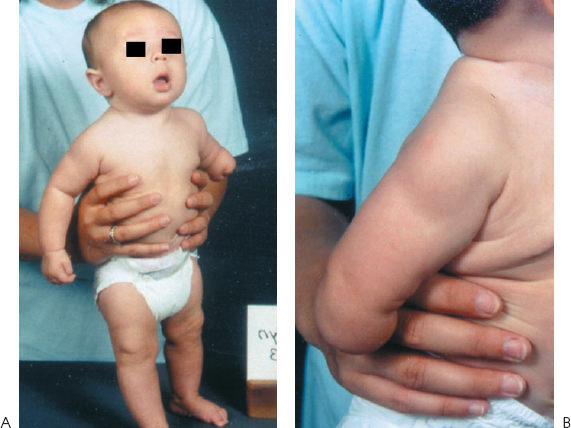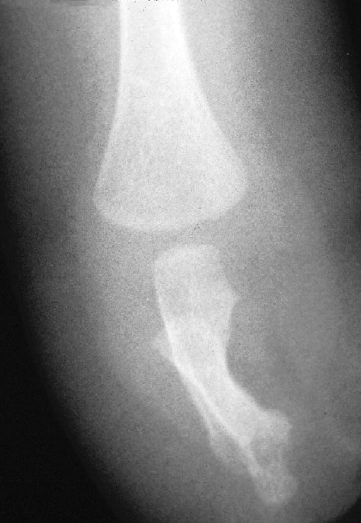74
Short Below-Elbow Amputation
Roberta T. Ciocco and Scott H. Kozin
History and Clinical Presentation
A 4-month-old girl presented with congenital deficiency of the right upper extremity (Fig. 74–1). She was born 2 weeks early by cesarean section secondary to low amniotic fluid. The child presented with no other medical or developmental problems. There was no family history of congenital anomalies, including her two sisters.
PEARLS
- Transverse deficiencies of the upper extremity occur most common just below the elbow.
- Transverse deficiencies are usually unilateral, sporadic in occurrence, and rarely associated with other anomalies.
- Early fitting (before 2 years of age) increases the acceptance rate of upper limb prosthetics
PITFALLS
- Surgery usually is not necessary for short, below-the-elbow deficiencies.
- Limb lengthening of forearm transverse deficiencies is usually not indicated.
Physical Examination
The patient was a healthy young infant with partial amputation of the right upper extremity. The shoulder and elbow had full active and passive range of motion. The proximal third of the forearm was present with the remaining extremity absent. The residual stump was well padded and there were several small nubbins at the end. The other extremities were normal and no amniotic bands were appreciated.

Figure 74–1 (A) A 4-month-old child with congenital anomaly of the right upper extremity. (B) Normal-appearing shoulder, elbow, and proximal forearm and absence of remaining extremity.
Diagnostic Imaging
Radiographs of the right upper extremity demonstrated a proximal forearm with a shortened and dysplastic radius and ulna (Fig. 74–2). There was no evidence of osseous development of the remaining forearm, wrist, or hand structures.
Differential Diagnosis
Amniotic band syndrome
Congenital transverse deficiency
Radial deficiency
Intrauterine necrosis of the right forearm
Amniotic band or constriction band syndrome is a result of entrapment of developing embryonal tissue by the fetal lining. This can manifest as amputation of a part and most commonly affects the digits (hands or toes). The diagnosis of constriction band requires the presence of a constriction band either in the involved extremity or elsewhere. Radial clubhand is a longitudinal deficiency of the preaxial border of the upper extremity. The radius can be partially or completely absent and the wrist is positioned in radial deviation. The ulna is present, although shortened compared with normal. Radial clubhand is often associated with visceral abnormalities (e.g., cardiac or genitourinary). Intrauterine necrosis of the forearm is a rare abnormality characterized by varying degrees of necrosis of the upper extremity evident at birth. The clinical manifestations range from minor areas of skin and muscle damage to mummification of the entire forearm. The etiology is either direct pressure on the affected limb or thromboembolic disease.

Figure 74–2 Radiograph of right arm with absence of the distal two-thirds forearm, wrist, and digits.
Diagnosis
Congenital Transverse Deficiency
Stay updated, free articles. Join our Telegram channel

Full access? Get Clinical Tree








